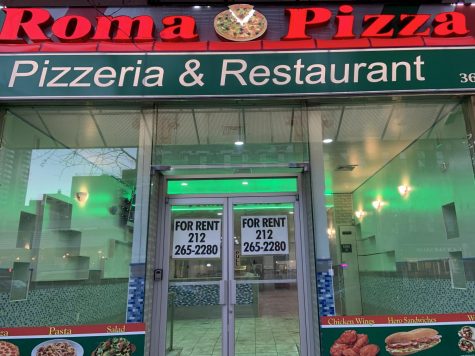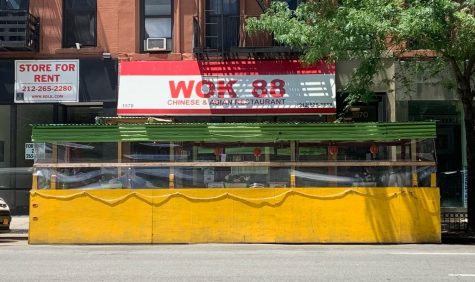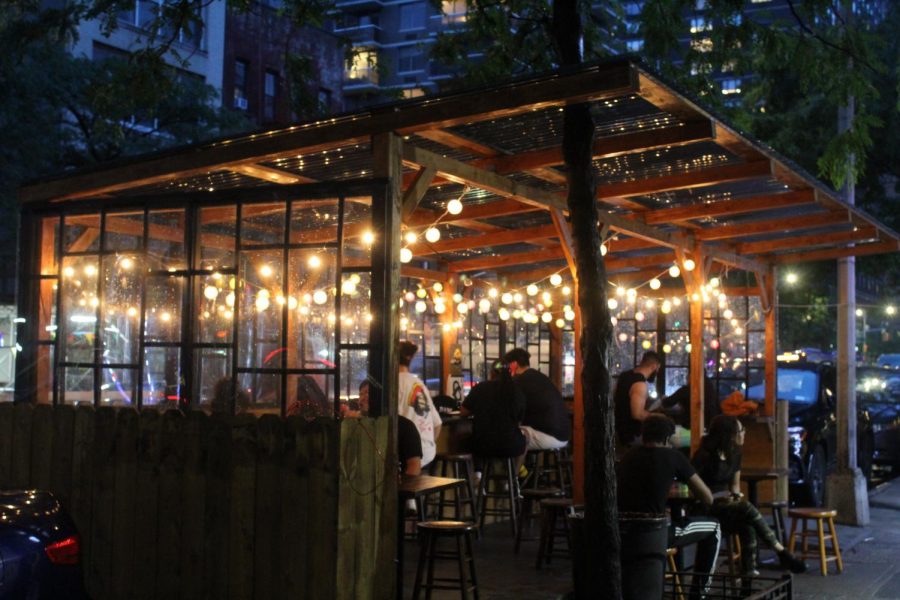The Trials and Tribulations of New York City’s Restaurants During the Coronavirus Pandemic
How the Coronavirus pandemic has effected the lively New York City restaurant industry.
During the Coronavirus pandemic, many restaurants invested heavily in outdoor dining spaces, such as this one, decorated with cheerful lights.
The Coronavirus pandemic has disrupted many plans that people may have had over the past fifteen months. Vacations and special events have been cancelled due to the travel restrictions that have been put in place throughout the world. As for the residents of New York City, one important factor of their everyday lives has been heavily effected — the restaurants.
New York City is known as the “restaurant capital of the world” due to its diverse food options throughout the city. Depending on the neighborhood you find yourself in, you could find some amazing food, no matter the time or the day of the week. Many people come to New York and are surprised by the variety of places that they can go to eat. After the pandemic hit, however, many restaurants were forced to close due to a lack of business and to quarantine restrictions, and the infamously high rent that comes with having a business in New York quickly took a toll. LanZhou Ramen, a restaurant in Queens, owned by the family of one of our Bronx Science families, “used to hand pull the noodles in front of customers as a form of art before the pandemic, and the restaurant really brings the comfort of home,” said Yu Wang ’23. Although LanZhou Ramen has now reopened, the beginning of the Coronavirus pandemic was a disheartening time for many family owned businesses like theirs.
Many restaurants were not able to make it through to reopen. Restaurants including Roma’s Pizza, Vinny Vincenz Pizza, Mu Ramen, and Diamond Reef have permanently closed. This is only to name a small number of the close to 1,000 total New York City restaurants that have had to close due to the financial fallout from the Coronavirus pandemic.

Although they are a vital part of the city, and many people rely on them for daily meals and sustenance, New York City restaurants were no exception to the worldwide shutdown that came in response to the COVID-19 outbreak. For many restaurants, even though dining-in was no longer an option, delivery still continued. Food delivery services such as Seamless, Grubhub, Doordash, and many more have been able to more than double their business during the past fifteen months of the pandemic.
Towards the end of June 2020, outdoor seating was permitted, and a whole new way of attracting customers began. Many dining establishments took advantage of this opportunity to draw in customers by making their outdoor seating especially enticing and decorative. Outdoor seating almost became an experience in itself. Restaurants got creative and built entire structures on New York City streets to make the outdoor experience as comfortable as possible. Some of these options were heated, others had individual rooms for each table, some even had bubbles lined up on the street for each table of guests to be seated in. An example is the Savanna Rooftop in Long Island City. They have individual glass houses, resembling greenhouses, lined up along the East River, with a spectacular view of the Manhattan skyline.

These outdoor options provided New Yorkers with a chance to leave their homes, go outside, and meet up with their friends, all while maintaining social distancing and doing so in a safe manner. It also brought life back to the streets and helped New York City to be able to continue to claim the title of “The City that Never Sleeps.”
Even though there is nothing that we can do for the restaurants that have already closed, we can continue to support our local restaurants still in business. Ordering directly from the restaurant (when that is an option), rather than using a delivery service, can help them save percentage of costs that a delivery service would end up taking. Trying new places and avoiding fast food chains is also a way to support smaller restaurants.
While the Coronavirus pandemic has been a devastating time for many of us, as the country begins to open up and COVID-19 vaccines are administered with increasing numbers of Americans vaccinated, restaurants and other small businesses have been able to reopen. With our help, these pillars of New York neighborhoods will continue to warm our hearts and feed our stomachs.
Although they are a vital part of the city, and many people rely on them for daily meals and sustenance, New York City restaurants were no exception to the worldwide shutdown that came in response to the COVID-19 outbreak.

Suhani Madan is the Chief Photography Editor and Managing Editor for ‘The Observatory’ yearbook. She enjoys photography because it allows her to capture...

